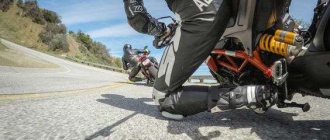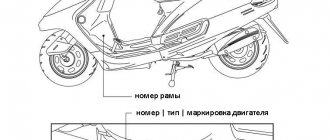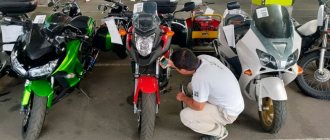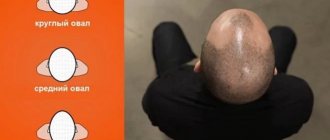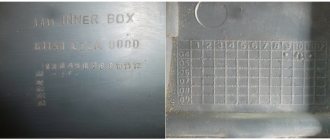Knock in the area of the leading star
- Log in to reply to this topic
- Mine
- 815 messages
- City: Moscow, Central Administrative District, Russia
- Motorcycle: Honda XL600VT
- Quote highlighted
- City: Moscow, Russia
- Motorcycle: TA600 -> NTV 650 RC33
My shaft is in good condition, the sprocket is quite fresh and the pressure washer is new - the angular play is very insignificant, the longitudinal play is about 1mm.
- Quote highlighted
- City: Moscow, Central Administrative District, Russia
- Motorcycle: Honda XL600VT
isn't this one (No. 22 - OIL SEAL, 12.5X25X8) the case?
- Quote highlighted
- City: Moscow, Russia
- Motorcycle: TA600 -> NTV 650 RC33
thank you, that's what I need.
But what do you think, if you put larger front and rear sprockets while maintaining the ratio, the chain should become further from the shaft.
- Quote highlighted
- City: Moscow, Central Administrative District, Russia
- Motorcycle: Honda XL600VT
ok, then I’ll try not to forget about the partner in the evening
- Quote highlighted
- City: Moscow, Russia
- Motorcycle: TA600 -> NTV 650 RC33
- Quote highlighted
- City: Moscow Region, Pushkino, Russia
- Motorcycle: Honda Transalp xl600
- Quote highlighted
- City: Odintsovo, Russia
- Motorcycle: Transalp 700
ernest, I started to tap, but I blame the chain tension. The chain has covered almost 20,000 km, has stretched a little, and I only recently got the right tools. The chain sag is 4.6 - 4.7 cm, with a norm of 4 and a maximum of 4.5 according to the manual.
Why do you smear it so often? According to the manual, once every 1000 km.
- Quote highlighted
- City: Ryazan, Russia
- Motorcycle: Owl=> Java 638, CZ250 Cross=> CB400SF=> Transalp 650=> Triumph Tiger 800 XC
I think I have quite accurately determined the cause of the knocking in the area of the leading star. My problem manifested itself as follows: Motorcycle Transalp 650. When starting sharply and releasing the clutch, a single knock is heard somewhere behind, the sound is very similar to engaging first gear on a cold engine. This single knocking noise occurs in any gear with a large amount of gas and a rather abrupt release of the clutch. It got me off-road. You need to accelerate to get out of the ditch, but something is knocking from behind... The chain is tensioned correctly, and it is new, along with the sprockets. The stars are installed correctly. Standing still with the front brake clamped and playing with the gas and clutch and looking at the chain, I saw that the chain jerked very strongly at the moment the clutch was released, and a knocking sound occurred. I blamed the chain slider and the chain hitting it. It turned out that the reason was somewhere in the clutch / If I turn faster and get under way, the speed gain when releasing the clutch goes smoothly without any jerks, but when I release the clutch handle, there is a slight soft push at the end. That is, the clutch seems to have two stages. Or at first it stalls more than expected, but then eventually picks up. Sometimes the clutch slips when starting sharply, but when you release the gas, the discs grab and then you can turn the gas all the way, there will be no slipping.
Due to the fact that the clutch has 2 stages this knocking noise occurs. I turned the secondary shaft while the gear was engaged, and as the star rotates, it has a free play of about a centimeter! it's normal, it's like that for everyone. So, when we engage first gear with the engine running, this knocking noise occurs. It’s the secondary shaft that has chosen its free play and hits something in the engine. (they did this at the factory, so this is also normal). So, when I sharply give the gas and play with the clutch, because of its “2-level” nature, after passing the first level sometimes such a knock occurs. The secondary shaft again selects its free play and hits something. I found only one way out - replacing the clutch friction discs and springs in order to get rid of the “two-level” nature of the clutch and, hopefully, completely eliminate the knocking noise when “playing” with the clutch.
- Quote highlighted
has been living here for a long time
- City: Moscow, Russia
- Motorcycle: since 2005 on TA-400V 93 onwards.
Bicycle fork overhaul and repair
In our bicycle workshop we overhaul and repair bicycle forks of all models (fox, rockshox, marzocchi, manitou, magura, cannondale, suntour, rst, formula) using different technologies depending on mileage and model, here are some prices and descriptions for work with forks bike:
Maintenance of new forks without traces of use price 900 RUR
Scheduled economy maintenance (includes changing the oil in the pants, cleaning from dirt, checking the pressure in the air chamber) - Price from 1100 rub
Full maintenance of the RockShox fork (changing the oil in the pants and damper, cleaning from dirt, lubricating the air chamber - Price from 1500 RUR
Maintenance or repair of the fork with replacement of bushing seals and other parts, including acceleration of the fork to the desired stroke - Price from 1100 rubles to 2000 rubles , depending on the complexity and time costs.
for models older than 2006, the price can vary from 900 to 2500 rubles depending on the design
Maintenance of new forks without traces of use. Price 900 rub.
Scheduled economy maintenance of a fork with a damper separated from the fork legs. Price from 1200 rub.
Fork maintenance including oil change and clean seals - Price from 1500 RUR
Maintenance or repair of Fox forks associated with replacing oil seals, bushings, cartridge overhaul, etc. (including rebuilding the cartridge of “X” forks with theralodgic and restoring the functionality of the cartridge) - Price 1200-3000 RUR
Fork maintenance including oil change and cleaning of dirt - Price from 1400 to 2300 rubles. During operation, only original oil is used.
Fork maintenance including oil change and cleaning of dirt - Price from 1600 RUR
Scheduled economy maintenance (includes changing the oil in the pants, cleaning from dirt, checking the pressure in the air chamber) - Price from 1100 rub.
Full maintenance of the Manitou fork (changing oil in the trousers and damper, cleaning from dirt, lubricating the air chamber - Price from 1800 RUR
Economy maintenance of forks with separated damping systems.
Price 1100 rubles
Fork maintenance with oil change and cleaning of dirt - Price 1800-2500 rubles
When working with Marzocchi , the price, work time, etc. can be determined in half the cases only in the workshop, since due to the sale of the Italian company in 2004 to suntour and the subsequent bifurcation of production and technology, a huge number of models were produced, each of which has its own nuances . From year to year, fillings, leg coverings, etc. were changed in dozens of models. Under different conditions of use in real conditions, Marzocchi forks behave differently and present more and more new surprises.
Correct bearing migration - Price 1400 RUR
Complete overhaul with replacement of corrugations, filter, cleaning of bearing cartridges - Price 3300 rub. (not including corrugation and filter)
We also carry out work on replacing bearings, changing the oil in the cartridge, changing repair kits for the fork air chamber (a fairly common problem when the Lefty air chamber deflates due to the upper position of the piston)
Materials and oils used for rebuilding and repairing bicycle forks:
Replacing bicycle fork seals
We replace seals in bicycle forks; we always have seals for the entire line of RockShox, FOX, Magura, Marzocchi, Manitou forks; we also have consumables and bearings for forks from Cannondale.
When replacing oil seals in forks, we use only original materials (attention, installing non-original oil seals quickly damages the guides and fork legs)
When working with forks, we are the only place in Moscow where all types of oils are used!! Motorex, Motul, FOX, Fox fluid, motorex supergliss, RockShox, Magura oils are always available. When rebuilding forks with us, you can use both original oils and their cheaper substitutes. Moreover, we have Motul and Motorex oil substitutes in all viscosities from 2.5 to 20.
The cost of an oil change is not included in the cost of service. All oils, with the exception of Magura and DT, cost 300 rubles, regardless of quantity. Magura and DT - 500 rubles. If you bring your own oil, we will fill it for free.
The uniqueness of our bicycle service lies in the fact that we have been working with forks for more than 10 years and have accumulated vast experience. Moreover, various shock-absorbing systems were rebuilt in our service using various technologies, and all our tests and experiments were tested and verified, not directly on bicycle tracks, because we are the only bicycle service that has assembled one of the strongest cycling teams in the cross-country discipline.
Cannondale FATTY - review and instructions from the Veloline service
Extraneous sounds in the moped engine
Quite often, moped owners complain about extraneous sounds in the engine. Everyone has long known that “a good knock will always come out,” that is, if you don’t find its source, expect a breakdown.
I bought my first moped Vento Rova II second-hand. During a test drive, I noticed a strange creaking sound that arose at the beginning of acceleration in each gear, but disappeared as it accelerated. The previous owner of the moped said that this sound has been present for a long time and no consequences have been observed from it.
For the first few months I just rode my moped to and from work. I must say that overall I received the moped in good condition, but it needed minor “finishing” and adjustment. At the same time, the extraneous sound did not become stronger, but did not weaken either.
Since I used the moped every weekday to commute to work, the repairs had to be done over the weekend. That is, it was necessary to remove and disassemble the engine, find the faulty part, buy it, replace it and put the engine in place. At the same time, a store with spare parts for Chinese mopeds was not so close to my house.
What knocks at idle on an alpha moped
What knocks at idle on an alpha moped. A very popular question. in this video I express my opinion purely, showing everything on the engine from Alpha 139fmb
LIFE YOUTUBE
Hello everyone, I have such a problem. What could it be? the gears began to turn on themselves when you start and drive even when the car is running in one place, please tell me about the noise in the engine, go to my channel and watch the video with the noise
Sergey Okun
In addition, your timing belt is noisy (the tensioner is not working.
Scooter engine noise - theory and consequences
Like any other internal combustion engine, a scooter engine is subject to wear and tear. This is a natural process and over time you will inevitably hear extraneous noises in the operation of the scooter’s engine, which one way or another may indicate rapid wear of the engine or transmission components.
The sounds can be different, from hissing to rumbling, from the usual clattering to a loud howl. Let's consider the main ones:
- In a four-stroke engine, the thermal clearances in the valve drive mechanism may have been damaged; in this case, the valves must be adjusted. The gaps must be set to those specified by the manufacturer.
- If your scooter is two-stroke and carbon deposits have formed in the combustion chamber, preventing normal operation of the engine, you hear detonation, the combustion chamber needs to be cleaned. To do this, remove the cylinder head, the cylinder itself, and use a wooden spatula to remove carbon deposits inside the cylinder windows and from the piston bottom. It is not necessary to remove the piston itself, just plug the hole in the crankcase with a small rag. In some cases, when the coking of the combustion chamber is insignificant, fuel additives that are specially produced for these purposes help.
- When the cylinder-piston group wears out, the gap between the piston and cylinder increases. At the same time, a peculiar clattering sound is heard when the piston skirt seems to be dangling in the cylinder. This phenomenon can often be found on Hondas with vertical engines.
- If the elements of the CPG are not tightened enough, you can hear a characteristic hissing and whistling. This is the sound of gases escaping. At the same time, the engine runs unstably and compression drops significantly. To fix this breakdown, you need to tighten all the engine threads and check the integrity of the gaskets. Particular attention should be paid to the condition of the gasket between the cylinder head and the cylinder.
- Wear of crankshaft bearings is one of the most labor-intensive breakdowns. To replace the bearings, you will need to “prick” the engine, and this is beyond the power of an amateur scooter rider. The sound when the bearings wear out cannot be confused with anything - it is a howl when gas is added. The howling can be short-lived, it can appear immediately from the start, or maybe after a few kilometers of travel. If the bearing has shattered, you may hear a characteristic cracking sound when there is strong gas release on the center stand. Worn upper and lower connecting rod heads also produce strange noises when the scooter engine is running. Repair consists only of replacing damaged parts.
- In a four-stroke engine, the valve train drive chain may become loose. At the same time, you will also hear an extraneous clattering sound, which is eliminated by proper chain tension. Perhaps the chain has already worn out, then it needs to be replaced.
Adjusting valves on an Alpha 110cc moped
Hi all! This article will discuss adjusting valves on an Alpha 110cc moped. I won’t explain why you need to adjust the valves. Everyone understands that incorrectly set gaps negatively affect the performance of the engine, leading to timing failure and repair.
- Before you start adjusting the valves
- Setting TDC on Alpha
- Let's start adjusting the valves
- Correct assembly after adjustment
- Video of valve adjustment on Alpha RX
MY MOTORCYCLE
The internal combustion engine operates with a certain noise due to its design features. In general, noise, to one degree or another, is characteristic of almost any operating mechanism. However, an increase in noise over time or a change in its character always indicates changes in the geometry of parts, or, more simply, about wear. Wear of scooter engine parts is inevitable during operation. The quality of these parts themselves, the intensity of operation, and the use of high-quality lubricants and combustible materials determine how quickly the moment of inevitable replacement of an engine part will arrive.
Listen to the engine
A scooter owner should always listen to the operation of the scooter's engine. Listen for noise at idle, when accelerating, and at top speed. After using the scooter for a certain period, the normal operation of the engine is remembered by the driver, which means that any change in engine noise in the future should be alerted. All that remains is to study them in more detail, which is what we will do now.
How to identify the source of noise
To determine the source of extraneous noise, there is a special device - a phonendoscope (like the one in the photo))). However, an experienced technician will always identify a breakdown even without additional equipment, because there is nothing complicated about it, everything comes with experience. Sometimes you may feel additional vibration or increased heating at the site of the breakdown. In practice, the source of extraneous noise in a scooter engine can be most accurately determined if it is possible to change the tone of the noise as the engine speed increases or decreases. To do this, sharply turn the throttle and listen to the engine. In this case, defective main bearings, cylinder, piston, rings, connecting rod, etc. show themselves very clearly. Sometimes you need to ride a scooter on the road to determine other noises. Thus, localization is determined, and then, most likely, the part that produces extraneous noise is determined. Now all that remains is to do an “autopsy” to confirm the diagnosis and decide on a further series of actions to restore or replace the damaged part.
The nature of extraneous noise in the scooter motor, the cause of its occurrence and location:
- Knocking sound in the scooter engine during glow ignition.
Ignition of the working fuel mixture during the compression stroke due to engine overheating, carbon deposits on the piston, carbon deposits on the cylinder head and a number of other conditions contribute to the appearance of glow ignition.
The nature of the engine knock during glow ignition is similar to the knock with a large ignition advance, due to the flash of the mixture advancing ahead of the spark in the spark plug. In this case, the glow ignition process is accompanied by pronounced detonation of the fuel. To confirm the knocking sound during glow ignition, you should turn off the ignition and listen to the noise - flashes should continue. The engine is stopped by sharply turning the throttle all the way with the ignition off. Eliminating glow ignition is identical to eliminating the causes of engine overheating.
- Knock in the scooter engine when the working fuel mixture detonates.
Fuel combustion with detonation is most often characterized by the appearance of a metallic knock in the scooter cylinder when the load increases. Detonation usually occurs when the scooter engine overheats, the spark plug has a low heat rating, the use of low-octane gasoline or low-quality gasoline, and also when there is a large amount of carbon deposits in the combustion chamber. You should not operate the scooter when detonation occurs, as this can lead to premature wear of loaded parts due to vibration and improper engine operation. Temporary detonation knocks occur when the mixture is lean, early ignition, engine overheating, or engine overload. Therefore, when detonation knocks appear, you should first of all reduce the load and, if necessary, enrich the mixture. In case of detonation, try filling the scooter with gasoline with a higher octane number (for example, instead of 92 gasoline, fill in 95), check and, if necessary, clean the combustion chamber from possible carbon deposits.
- Scooter piston rings knocking.
This type of noise is relevant for two-stroke engines. The distinct knocking sound of the rings is clearly localized in the cylinder and appears due to the rings falling into the purge windows inside the cylinder mirror. Structurally, this should not happen, because the rings are fixed on the cylinder using stoppers in such a position that the locks, by definition, cannot be located in the location of the purge window. However, movement of locks often occurs when the rings wear out, the stoppers wear out, and when the lock pops out of the stopper (this also happens). The falling rings produce a characteristic sound, which is emitted from the middle part of the cylinder (the middle part of the cylinder is determined by listening with a special instrument) and is characterized by a timbre ranging from rustling to rhythmic ringing, provided that the rings are still intact. But when the rings break (and in this case it will definitely happen), a characteristic crunch and intense knocking can already be heard from the cylinder due to ring fragments getting into the cylinder purge windows. Operation of the scooter in this case is unacceptable. The debris should be removed and all damaged parts replaced.
- The knock of the piston on the cylinder mirror.
When the piston knocks on the cylinder bore, it is said that the piston skirt is knocking. Due to the increased gap between the piston skirt and the cylinder mirror, the piston skirt very clearly hits the mirror when passing through TDC. The noise is localized in the cylinder and appears immediately after starting the engine during warm-up, before the piston has yet accepted the working expansion from heating. Once the engine reaches operating temperature, the sound usually loses intensity and volume, and sometimes disappears completely with mild wear. A similar noise can also occur after a “crooked” engine assembly, when the parts are not moving enough.

